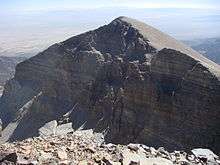Quartz arenite

A quartz arenite or quartzarenite is a sandstone composed of greater than 90% detrital quartz,[1] with limited amounts of other framework grains (feldspar, lithic fragments, etc.) and matrix. It can have higher-than-average amounts of resistant grains, like chert and minerals in the ZTR index.
The term 'quartz arenite' is derived from the main component (quartz) and arenite, a Latin term for a rock with sand-sized grains. In some literature, these can be called orthoquartzites, a confusing term which usually refers to the metamorphic rock quartzite, though most metamorphic quartzites are diagentically fused from quartz arenites. The term "quartzose sandstone" can also be used for a quartz arenite.
Quartz arenites are the most mature sedimentary rocks possible, and are often referred to as ultra- or super-mature, and are usually cemented by silica. They often exhibit both textural and compositional maturity. The two primary sedimentary depositional environments that produce quartz arenites are beaches/upper shoreface and aeolian processes,[2] due to their high residence time, high transport distance, and/or high energy of the environment. Most of the time, these sediments are reworked over and over, even being eroded out of a lithified rock and becoming a brand new sediment and rock. This is known as a multicycle sand.